Daffodils
On a walk with his sister, Willam Wordsworth, an English Romantic poet, discovers a field of Daffodils. Their beauty on that breezy day inspired him to write this poem. It talks about nature and the comfort of remembering it in the “bliss of solitude.”
Meet the Poet
- William Wordsworth was an English Romantic poet. His poems have a deep connection to nature and spirituality.
- Born: 7 April 1770
- Place of Birth: Cumberland, Lake District of England.
- Died: 23 April 1850
- Major Works: The Prelude and Lyrical Ballads co-written with Samuel Taylor Coleridge
- Best Known For: He is known for advocating the use of simple language in poems to appeal to common people and a deep connection between humans and nature.

Share Options
Summary of the Poem
Daffodils is a good example of Wordsworth’s writing style and his ideal type of poetry. It shows a free expression of the poet's thoughts and feelings. The celebration of nature is also apparent in the poem. This poem delves into the theme of nature's comfort, especially in moments of solitude.
This simple poem focuses on the beauty of the daffodils and the happiness they bring to the poet. He describes these flowers as fluttering and dancing in the breeze, a joyous sight that captivates him completely.
A host, of golden daffodils;
Beside the lake, beneath the trees,
Fluttering and dancing in the breeze.
The daffodils are compared to the stars in the Milky Way, stretching in an unending line along the shore of a bay. This sight outshines the sparkling waves of the lake, bringing a kind of joy to the poet that he had never experienced before.
Continuous as the stars that shine
And twinkle on the Milky Way,
They stretched in never-ending line
Along the margin of a bay:
Even the memory of this scene recalled in moments of solitude or reflection, fills the poet with bliss. He feels that his heart is in sync with the daffodils' dance.
Which is the bliss of solitude;
And then my heart with pleasure fills,
And dances with the daffodils.
The poem concludes with Wordsworth finding solace and rejuvenation in this recollection, transforming his initial loneliness into a serene "bliss of solitude.”
"Daffodils" is more than just a depiction of a beautiful scene; it expresses the joy and peace found in nature. Wordsworth's experience with the daffodils serves as a poignant reminder of the solace and happiness that nature can provide, encouraging readers to seek and cherish these moments of connection with the natural world.
This is a lyric poem, the poet's feelings, state of mind, and perceptions. In this case, Daffodils deals with the poet’s feeling of joy and bliss in nature.
The first three stanzas describe the image of the daffodils then he uses the fourth and last stanzas to explain his feelings of recollecting this experience. The use of vivid descriptions to explain a scene is a literary device called Imagery. Wordsworth has used this throughout the poem. He used colours and actions to create a detailed picture, for example:
- golden daffodils : stanza 1 line 4
- Fluttering and dancing in the breeze : stanza1 line 6
- twinkle on the Milky Way : stanza 2 line 2
- Tossing their heads in sprightly dance : stanza 2 line 6
- The waves beside them danced : stanza 3 line 1
- sparkling waves : stanza 3 line 2
- flash upon that inward eye : stanza 4 line 3
- dances with the daffodils : stanza 4 line 6

Wordsworth also uses personification, where he gives a human attribute to something inanimate or abstract. For example:
- Tossing their heads in sprightly dance : stanza 2 line 6
- The waves beside them danced; but they Out-did the sparkling waves in glee : stanza 4 line 1&2
Additionally, he uses literary devices like:
- Simile : Continuous as the stars that shine
- Metaphor : I wandered lonely as a cloud
That floats on high o'er vales and hills - Alliteration : Ten thousand saw I at a glanc
- Hyperbole : They stretched in never-ending lin
Along the margin of a bay:
Ten thousand saw I at a glance
The rhyming scheme is ababcc, meaning that alternate lines are rhyming and each stanza ends with a rhyming couplet.
Share Options
Above and Beyond the Text
Romanticism
The poem is a representation of Romanticism, a literary movement during the late 18th and early 19th centuries that revered nature and emphasised human emotions. It also explored themes like the supernatural, the sublime, and personal freedom. Key writers included William Wordsworth and Samuel Taylor Coleridge in England. The movement came as a reaction against the Industrial Revolution's rationalism, celebrating creativity, the beauty of the natural world, and the depth of human feelings.
Share Options
Get Personalized Tuitions
We offer premium education on a personalized level. Online tuition for all grades, tailor-made!

Daffodils Questions and Answers
Below are a few questions that you can look out for your examinations and class tests. Stand out with perfectly written answers with help of Aneetta Class.
Nature’s Beauty: The poem is a testament to the stunning beauty of nature and its ability to affect our emotions. Solitude and Inner Peace: It highlights how solitude can lead to moments of deep connection and joy through the appreciation of nature. Memory and Reflection: The poet shows how pleasant memories can provide comfort and happiness in times of solitude.
Simile and Metaphors: The poet uses these to compare himself to a cloud and the daffodils to stars.Personification: The daffodils are given human-like qualities, as they dance and flutter.Imagery: Wordsworth employs vivid imagery to paint the scene of the daffodils and the lake, making it almost visually palpable to the reader.
The deep impact of nature on man is often a theme in Romantic poets and the same is the case in Daffodils. Wordsworth shows the power of nature to heal and to connect you to the world even during moments of solitude. The poem is also a good example of Wordsworth’s theory where he believes that good poetry is a “spontaneous overflow of powerful feelings arising from emotions recollected in tranquility”. This poem has intense feelings of joy and bliss that are remembered: “In vacant or in pensive mood.”